Dipping the Madeleine: Finding Your Hidden Memories
“And suddenly the memory revealed itself. The taste was that of the little piece of madeleine which on Sunday mornings at Combray … when I went to say good morning to her in her bedroom, my aunt Leonie used to give me, dipping it first in her own cup of tea or tisane …. and the whole of Combray and its surroundings, taking shape and solidity, sprang into being, town and garden alike, from my cup of tea.”
After dipping a madeleine in verbena-infused tea, Proust’s boyhood memories played out before his very eyes. After a few more sips and a few more dips, he transformed his entire life—all that he knew about history, cultural mores, social privilege, art, science, and human nature—into what is arguably the greatest novel of the 20th century. If not a memoir, it’s an autobiographical treatise in the guise of a novel. Dipping the madeleine proved an antidote to the much-dreaded writer’s block.
What Proust stumbled upon was a way to feed the artist within. And what about you? Have you tried ‘dipping the madeleine,’ have you found ways to nourish your artist-soul? As memoirists, we are called upon to revisit our earlier selves. To do so, we need something that will trigger the involuntary memories, many of which may have lain dormant for years.
There are many ways to nourish the writer within. One of the things Proust did was to visit art galleries. In his seven volume 3,000-word novel, he mentions more than 100 painters and discusses dozens of paintings, likening them to his subjects. The Florentine fresco below, which had been seen by Proust, was commented upon by Swann who compares the lovely Zipprorah to the love of his life, Odette.
Sandro Botticelli: jethro's Daughter Zipprorah
Proust believed that when involuntary memories arise, we see the past as if it were the present. And, truthfully, that’s how it felt, when I went back to the Bronx to see the building on Ryer Avenue in the South Bronx where we had lived until my mother died.
Casting about, trying to find anything I may have remembered, the block was unfamiliar and that thermoplastic door with the intercom to the side did not ring a bell. Nor did the industrial light fixture snaking overhead, No, these are more recent additions.
But in mind’s eye, I saw the small black-and-white octagonal tiles on the bathroom floor, felt the silkiness of the tufts on my mother’s chenille bedspread, heard the music of the Big Bands playing in the background. Details I had not thought about in years, all of which would come together to form the opening passages of Veronica’s Grave.
Neuroscientists tell us that memories are not lost, but are contained within the cells of our body. That said, in order for an involuntary memory to surface—to move out of the hippocampus into the realm of consciousness—there has to be a trigger.
Fashionable Women: Avenue Bois de Boulogne 1911
For authors juggling the hurried demands of everyday life, it often feels as if there’s little time to collect one’s thoughts, no less to listen and reflect on them. Fortunately, ‘triggers’ can be found everywhere if we are open to them. A trigger could be something as ordinary as a conversation overheard on a street corner, the yeasty scent of bagels wafting down a street or the feel of a starchy linen napkin—as was the case for Proust.
When doing readings and book signings for Veronica’s Grave, a question that has come up regularly has to do with my writing schedule and how I found the voice of the young narrator.
The very question I've been asked to address by the National Association of Memoir Writers in a teleseminar Friday, November 18th.
11 AM PDT 12 PM MDT 1 PM CDT 2 PM EDT
We will discuss:
- Opening the gates to the subconscious and letting unbidden memories rise into consciousness.
- Rise and Shine!
- Recharge the synapses
- Start the Day with Self-Affirmations
- Write the Morning Pages
- The Virtues of Longhand
- Trust the Voice in Your Head
If interested, click here and go to the bottom of the page to sign up. After the first 45 minutes of the teleseminar you will have a chance to ask questions. I'm looking forward to being with you and with Linda Joy Myers, Ph.D., the dynamic founder and president of the NAMW and the author of The Power of Memoir—How to Write Your Healing Story.
Thanks for stopping by! Hope to see you next Sunday. Leaving you with a sweet thought... Click here and take your pick! Merci beaucoup. À bientôt!




